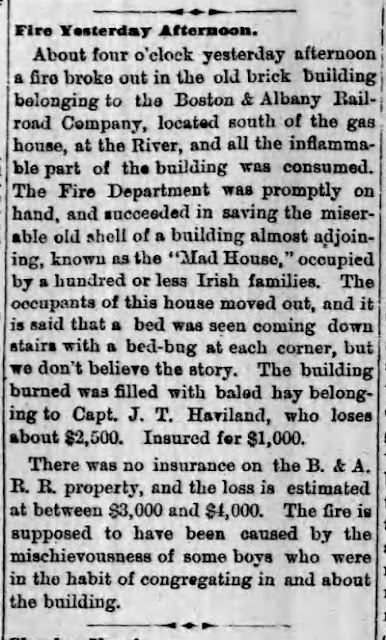Since April 2020, when a metal deck was installed to halt the building's continuing deterioration, the Dunn warehouse has retreated to the back burner of the City's concerns.
Yesterday, while perusing the Hudson Daily Star for December 26, 1871, I discovered this report of a fire that took place on Christmas Day 150 years ago, which may provide a snippet in the building's long history.
It's hard to imagine "the old brick building belonging to the Boston & Albany Railroad Company" being anything other than what we now know as the Dunn warehouse, although in 1871 it wouldn't have been more than about 20 years old. In the 1985 survey done for Hudson Historic District National Register nomination, the Dunn warehouse is identified as the "Hudson and Boston Railroad Shop," and its date of construction is given as c. 1850. On the maps below, the first from 1858 and the second from 1873, the "gas house" (the Hudson Gasification Works) is the round structure. What is now the Dunn warehouse is the smaller building at the corner of Broad and Water streets.
Perhaps the larger building that appears on both maps, at the corner of Franklin and Broad streets, is the so-called "Mad House" where Captain J. T. Haviland stored his bales of hay.
One thing did not change in Hudson from the 19th to the 20th century: the cause of the fire. "The mischievousness of boys" cited as the cause of the fire in 1871 was also the cause of the fires that destroyed the old St. Mary's Academy in 1973, Candy Lane in 1979, and Hudson Electrical Supply in 1994.
COPYRIGHT 2021 CAROLE OSTERINK





Peter H. Stott in his book "Looking for Work, Industrial Archeology in Columbia County, New York", copyright 2007, Columbia County Historical Society, says that the building that eventually became the Dunn Warehouse was constructed in 1889 after the merger of the Hudson Gas Company with the Hudson Electric Light Company in November 1888, forming the Hudson Light and Power Company. "The Birds Eye View of Hudson, New York 1881" H.H. Rowley & Co. Hartford, Conn., shows the hexagonical gas works structure with the New York Central & Hudson River Railroad freight house to the upper right of the gas works and, on the lower right, a small gable-roofed building and what appears to be an open air coal bin along Water Street. There is no sign of the present-day Dunn structure, which makes sense if the railroad building burned down in 1870 and the building that became the Dunn structure wasn't built until 1889 as Peter Stott says.
ReplyDeleteI would be more interested in the history of the "Mad House".
ReplyDeleteme too! Is it 100 or less Irish families or people? 100 families is a lot. As an Irish person I am intrigued.
DeleteIt is a shame that in a historic city a building like this is left to rot while under the protection of the local government. Hopefully the next council will have more interest in preserving the historic assets of the city.
ReplyDeleteMaybe I'm wrong, but I read it as the "Mad House" and the building used to store hay were separate. The building with the hay burned down while the "Mad House" was saved.
ReplyDeleteI read it that way too. The railroad building (with hay) burned down.
Delete